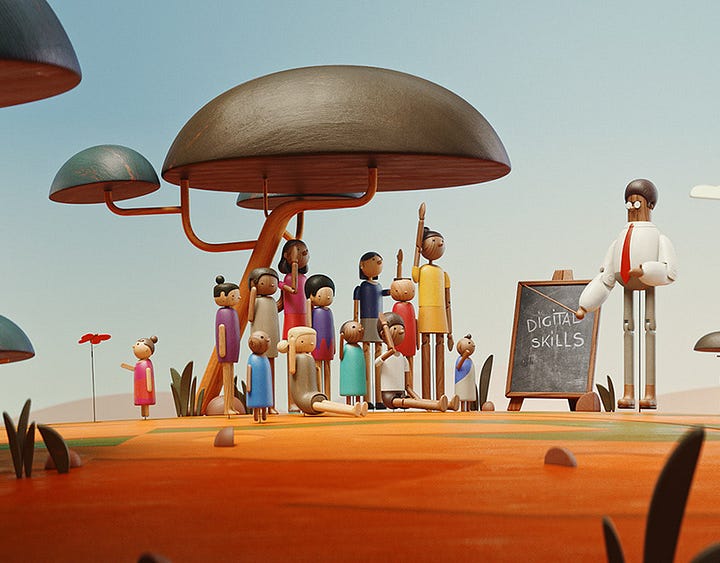When I first began my career as a 3D artist, I was ambitious. Sure, I was just a lowly Lighting Technical Assistant (glorified Render Wrangler), but I knew what I wanted—to move up. Not only to earn more money or make more art, but because that's just what you do, right? You get a job, you work hard, you get promoted, and repeat until you’re wearing a monocole in a tuxedo with tails. Why would anyone not want to just keep striving to impress those above you in a bid to move up the ladder?
At Blue Sky Studios, this path for advancement was clear:
Junior Lighting TD -> Lighting TD -> Senior Lighting TD -> Lighting Lead -> Lighting Supervisor -> CG Supervisor -> some fancy executive title -> monocole life. Pretty straightforward—I assumed everyone was climbing that same ladder and trying to achieve those goals.
Then I met a guy who changed my thinking. He was a brilliant Senior Lighting Artist, quiet (which others read as gruff) but always sweet and patient with me.
I figured he'd make a great Lead. Why not promote him?
But I learned the company had tried—and he said no.
No? To a promotion? To more money and a better title? Who would turn that down?
He said just didn't want to manage anyone. He wanted to focus on art. Moving from Senior to Lead was a totally different job. As a Senior, he got the tough but amazing shots. As Lead, you light less but oversee the team on a sequence—meetings with directors, leads from other departments, figuring budgets and schedules. Creating shot assignments, teaching juniors, managing spreadsheets and statuses.Basically, Lead means switching from individual contributor to people manager. And that wasn't the career he wanted.
Then it hit me…he was content. This idea of always striving for the next level was a fool’s errand without a clearcut goal and knowledge of when to turn down opportunities that could lead you down the wrong path. He knew what he wanted to be happy and knew when to say no to a new shiny thing.
This was a key moment in my career because I learned there are two main paths as anyone pursuing a creative career —People Manager and Expert Artist. Over my career I’ve done both and I have some thoughts!
The People Manager Track
Let's start with the management path since that was the only one I knew about. Prove your skills, impress higher-ups, get promoted from an artist to a leader —pretty straightforward.
But each step takes you further from hands-on art and more into managing others doing the work: overseeing more people, eventually overseeing the overseers. For many, this is the complete opposite of why they got into this industry. They wanted to create things and push themselves artistically. If they wanted to deal with management stuff, there were countless other career paths to follow.
But for others, it could lead to a perfect work environment. It’s great for those who’ve grown tired of working on their own and strive for more collaboration. Those that would rather put their team first and not their own individual creations. Those invigerated by motivating people with different personalities and bringing out the best in them.
But it’s not all team building, trust fall goodness.
Often as a middle management leader, you are stuck in the stressful position between company leadership and the artistic team. You will often have to be the voice of your team and stand up when decisions are made that will adversely effect them. And despite your best efforts, higher-ups might still make an unpopular decision and you have to implement it with the team.
There are also times you have to make truly difficult decisions that will greatly impact other people’s career and life. I had great insight on that recently…
I asked a family member, starting a business after years managing others, what her company would do differently. "Fire people faster," she instantly replied. From this warm, kind person whose was starting a business to help others!
How could that be!?! Was she secretly a monster!?!? Was she already the tycoon wearing the monocle and joyfully ruining people’s lives?!!? Muhahahaha….
She was not. She explained….
First, nothing kills team morale faster than someone sucking with no consequences. Think about it…you are being a rockstar and working hard and just crushing your job. The person sitting next to you is incompetent or lazy or just bad at the job. But they continue to carry on in their ineptitude, earning the same amount as you. What motivation do you have to keep working hard? Zero.
But also, she explained, underperformers usually don’t fit the job or lack skills. This job isn’t right for them and they need to be let go so they can find something better. She didn’t pretend like she was doing this person a favor by firing them more quickly but the times she had done it in the past, the person almost always found another job that was better suited for their skillset.
So in summary, good managers must:
Put team first
Handle different personalities
Influence or use authority as needed
Fight for team when needed
Coach struggling folks
Cut loose those who can’t improve
The Expert Artist Track
Instead of leadership, you can ignore all of that and focus purely on your craft by choosing the Expert Artist Track. This track isn’t about fancy job titles, but possibly higher job satisfaction. You won’t manage anyone or attend boring budget meetings and you can simply do the thing that you got into this job to do.
You can also elevate your skills to tackle complex problems that can lead to groundbreaking visual achievements. You will live at the bleeding edge of new workflows, tools, and artistic styles.
There will also be opportunities to mentor new artists as you will be the pillar of the company with vast experiences and a full range of knowledge to rapidly improve those around you.
Sounds ideal! What’s the drawback?
For one, the salary may be lower than leadership roles, but with enough expertise you can do live a very comfortable live (see a Blue Sky Sr. Lighting TD salary with just a few years’ experience from this previous article).
Also, after many years of working creatively, you may start to look for something different. Churning out artistic achievements day after day, week after week, year after year, can be draining and you may be ready for a change.
Depending on how you choose to work, the Expert Artist path could also entail a lot of freelance work. You would be a hired artistic gun who hops around from studio to studio selling your skills to the highest bidder. But that can get old after a while. You may want to settle in one location and have a family. Or maybe you have to care for an ailing parent and no longer have the flexibility to hop between London, Vancouver, and LA for various jobs.
The Expert path is great for those who:
Just wanna make art
Don't want direct reports
Value satisfaction over prestige
Are cool sacrificing some prestige
Conclusion
The mistake often made is great individual contributors get promoted without considering if they’ll be good managers. Their artistic skills go to waste in meetings staring at spreadsheets—stuff they don’t care about.
Don’t fall for this trap. Remember the career path you are working towards. Whether you choose Manager or Expert, take control of mapping your career to your skills and desires—this is your life! Don't be forced into roles not aligned with your vision and strengths.
3D News of the Week
Introducing Unity 6 - Twitter
Get KitBash3D Assets with 50% Discount - 80.lv
Spline Now Supports Gaussian Splats - Twitter -
10 insider tips for crafting a winning animation demo reel - CGChannel
Introducing Uniform : A new 2D/3D software - Twitter
Project Reframe: Recording and Editing Motion in Virtual Reality - AutoDesk
3D Merch is here!






Click here to Get Your 3D Artist Swag!
Artist of the Week
Sebastian Marek








3D Tutorials
3D Job Spreadsheet
Link to Google Doc With A TON of Jobs in Animation (not operated by me)
Hello! Michael Tanzillo here. I am the Head of Technical Artists with the Substance 3D Growth team at Adobe. Previously, I was a Senior Artist on animated films at Blue Sky Studios/Disney with credits including three Ice Age movies, two Rios, Peanuts, Ferdinand, Spies in Disguise, and Epic.
In addition to his work as an artist, I am the Co-Author of the book Lighting for Animation: The Visual Art of Storytelling and the Co-Founder of The Academy of Animated Art, an online school that has helped hundreds of artists around the world begin careers in Animation, Visual Effects, and Digital Imaging. I also created The3DArtist.Community and this newsletter.
www.michaeltanzillo.com
Free 3D Tutorials on the Michael Tanzillo YouTube Channel
Thanks for reading The 3D Artist! Subscribe for free to receive new posts and support my work. All views and opinions are my own!










